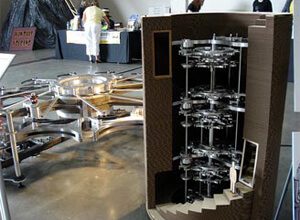The construction of clock, designed to tell the time for 10,000 years, is underway in Texas. The clock, when built, will stand over 60 metres tall and will have a clock face nearly three metres across.
Built by a non-profit organisation, the Long Now Foundation, the clock is being built so as to, not only still be standing in 10,000 years, but also still be telling the time.
 Consisting of a 300kg gear wheel and a 140kg steel pendulum, the clock will tick every ten seconds and will feature a chime system that will allow 3.65 million unique chime variations—enough for 10,000 years of use.
Consisting of a 300kg gear wheel and a 140kg steel pendulum, the clock will tick every ten seconds and will feature a chime system that will allow 3.65 million unique chime variations—enough for 10,000 years of use.
Inspired by ancient engineering projects of the past, such as the Great Wall of China and the Pyramids—objects designed to last, the clock’s mechanism will feature state-of-the-art materials that don’t require lubrication of servicing.
However, being an mechanical clock, the Long Now Clock will not be very accurate and will require resetting to avoid drift otherwise the time in 10,000 years will not represent the time on Earth.
Even atomic clocks, the world’s most accurate clocks, require help in preventing drift, not because the clocks themselves drift—atomic clocks can remain accurate to a second for 100 million years, but the Earth’s rotation is slowing.
Every few years an extra second is added to a day. These Leap Seconds inserted on to UTC (Coordinated Universal Time) prevent the timescale and the movement of the Earth from drifting apart.
UTC is the global timescale that governs all modern technologies from satellite navigation systems, air traffic control and even computer networks.
While atomic clocks are expensive laboratory-based machines, receiving the time from an atomic clock is simple, requiring only a NTP time server (Network Time Protocol) that uses either GPs or radio frequencies to pick up time signals distributed by atomic clock sources. Installed on a network, and NTP time server can keep devices running to within a few milliseconds of each other and of UTC.




